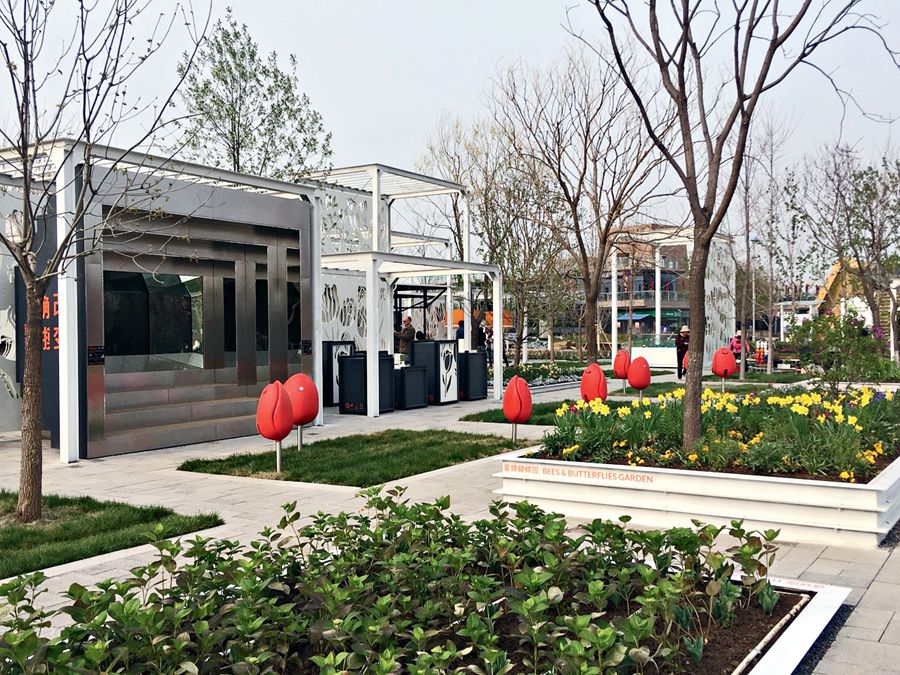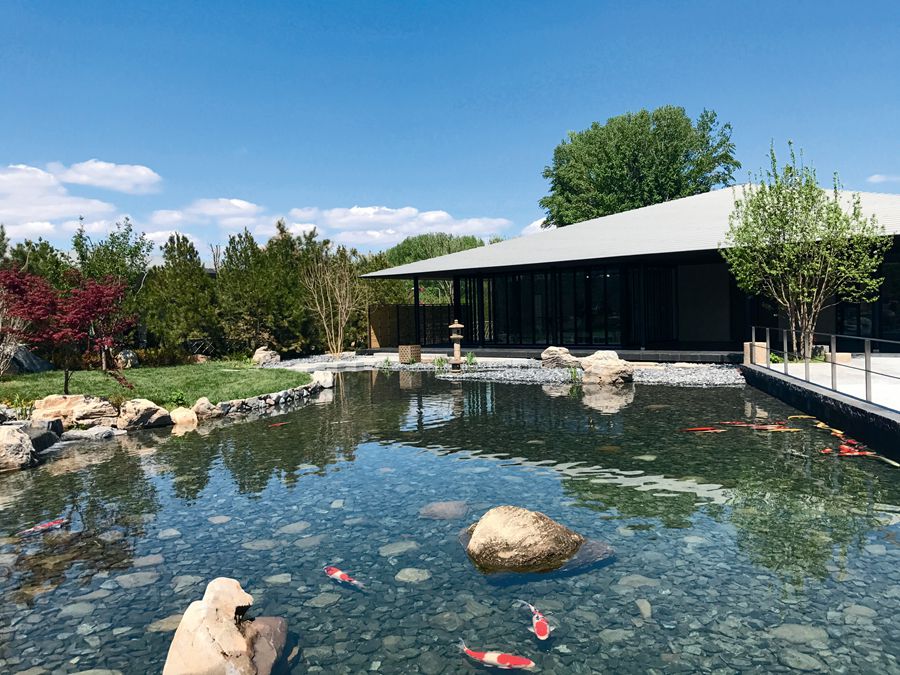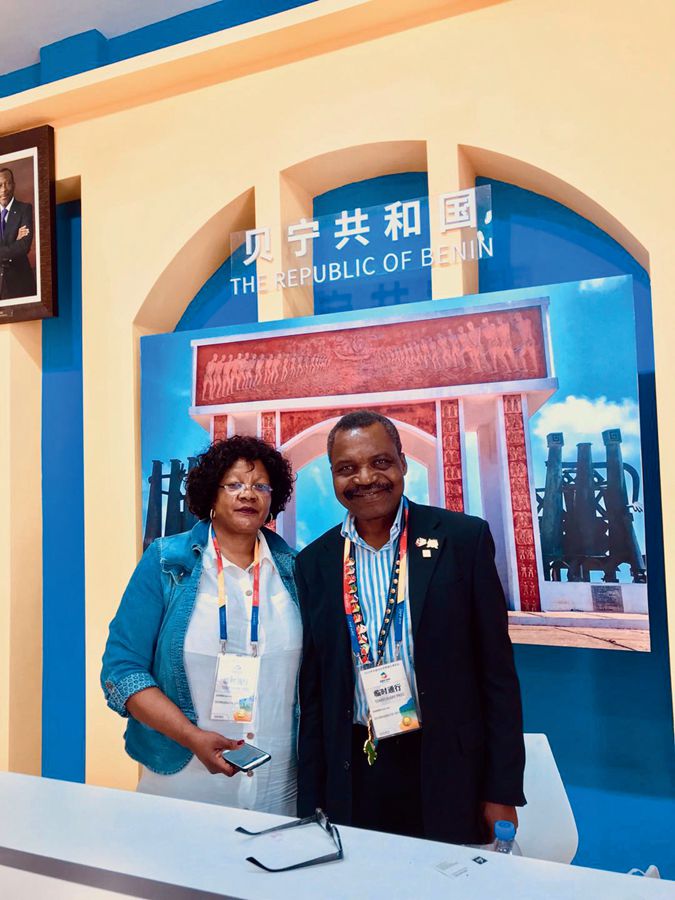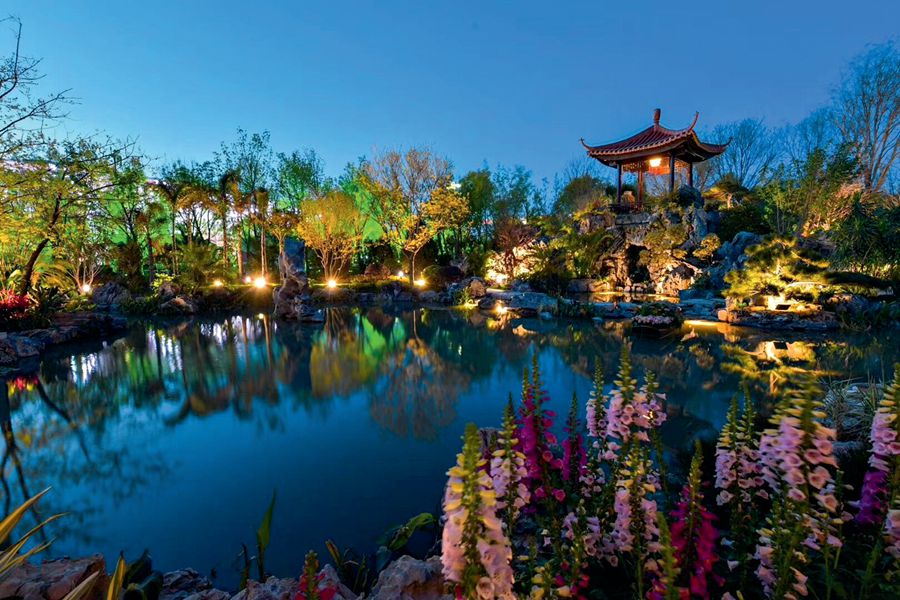ON March 23, 2014, a ceremony took place in the Netherlands during the state visit of China’s President Xi Jinping and his wife Peng Liyuan. The centerpiece of the event was a type of tulip which Madam Peng had been invited to christen with champagne and name by the Dutch King Willem-Alexander and Queen Maxima. On this occasion, Madam Peng decided to call the tulip the “Cathay Tulip” in honor of the old name for China once used in the Netherlands as well as the shared common dream of both countries expressed in the Chinese translation “Guotai” meaning “prosperous country.” The story of the Cathay tulip represents the ongoing dialogue between China and other countries in the field of horticulture and gardening. These kinds of “green ambassadors” will not only promote political relations but every other field from trade to green development.

The Dutch Pavilion exhibits various gardening techniques and products that are used in Holland.
This year’s International Horticultural Exhibition serves as a major platform for exchange and dialogue of various kinds of green ambassadors. The theme of the Beijing Expo is “Live Green, Live Better” and includes sub-themes of “green development,” “horticulture in life,” “harmonizing with the nature,” “education and the future,” and the “home of hearts.” On this platform, over 110 represented countries and international organizations share their story and aspirations of green development.
Green Homes: Harmony between Nature and the Home
As you enter the Japanese Pavilion, one can’t help but be impressed with the serene environment. Enclosed by an outer wall on all four sides, the exhibit is divided into two main parts: connecting with nature outside the home and bringing nature into the home. According to the pavilion director’s assistant, Li Jian, the theme of the Japanese Pavilion is realizing the harmony between plants, nature, and architecture, and living more in connection with nature. From the more earthen colors, simple designs and materials, and beautiful fresh flowers, each element in the exhibit harmoniously comes together to illustrate the philosophy of a Japanese home garden.
Outside the building, there is a small man-made waterfall, a pond with a few fish, and trees along the exterior walls. Along the inside of the surrounding wall, there lies a line of dark colored bamboo. The architecture of the building is built in the form of a house, with traditional Japanese walls facing the pond that can be folded together like a fan during summer months to allow the air to flow into the home. Inside the home exhibition, there were several small exhibits about how to enjoy and make flower arrangements. Ikebana is a traditional element of Japanese culture for arranging flowers and finding beauty in flowers.

With the theme of “Japanese Green Life,” the Japanese Pavilion exhibits Japan’s unique culture of integrating gardening and flower arrangements with home designs.
In addition to the natural exchanges which take place while visitors walk through the pavilion, according to Li Jian, many activities have been arranged throughout the whole exhibition during which the Nippon Flower Designers’ Association will invite experts and businessmen in the fields of horticulture, flower seeds, growing flowers, and businesses from Japan to have dialogues with Chinese and other foreign experts at the Japanese Pavilion. Themes of the activities vary with different months. From the beginning of the expo to July 5, the theme is “color of spring” with exhibitions of Ikenobo (one of the oldest schools of Japanese floral art). Then from July 6 to August 30, the theme will be “summer festival” with exhibitions of Ohara School of Ikebana, another school of Japanese horticulture which focuses on emphasizing seasonal qualities in landscape arrangements. From August 31 to the end of the expo, the theme will be “autumn harvest.” The exhibitions and dialogues in this period will center on Ikebana Sogetsu School, looking at how to make flower arrangements that are suitable for any and every setting and place.
Green Life in Cities: Living Walls, Green Roofs, and Thematic Gardens
Going from a rather serene home design with Japanese cultural themes that directly connects the elements of nature, architecture, and human life together, the story of how gardens could be combined with urban living and architecture is told by the exhibits of the Netherlands and U.K.

A section of the Benin Pavilion.
According to the designer of the Dutch Pavilion, Niek Roozen, “It is our desire to inspire people around the world to pay more attention to greenery, the quality of greenery in relation to food but also more attention to greenery in our cities.” Of all the open exhibits at the International Horticultural Exhibition 2019, the Dutch Pavilion attempted to let flowers and plants speak for themselves, having no enclosed buildings in their pavilion. The pavilion is integrated within the garden. In the Dutch garden exhibit, they have 13 different gardens, each of which has a different theme.
Beyond the small normal gardens that come to mind when people think of gardening, the British and Dutch pavilions displayed several unique and interesting ideas of better incorporating plants into urban development. Both pavilions exhibited one version of a living wall or green wall. This kind of garden design is a wall completely covered with green plants. Each plant container is connected on the inside to an integrated water delivery network system that supplies collected rain water from the roof or water from another irrigation system. This design emphasizes the principle of being environmentally friendly, utilizing rain water, and recycling natural resources. Roof gardens at the Dutch Pavilion are another kind of garden design that is beginning to become popular in modern urban development in the Netherlands and northern Europe. Not only can these gardens allow growth of plants and flowers, they can also prevent wasting rain water and reduce possible excess flow of water on streets.
In addition to innovative ideas of the location of the garden, both pavilions illustrated the idea of “thematic gardens” — an idea for designing gardens with different themes for different purposes. In the British Pavilion, these gardens included gardens for attracting bees and butterflies, biodiversity gardens for variety, botanical gardens (i.e. plants used in foods, drinks, and perfumes), children’s playground gardens designed with plants that absorb pollution (a common custom in the U.K. according to Steven Jewitt-Fleet, director of the British Pavilion), and healing gardens or sensory gardens which grow a variety of plants that are colorful, fragrant (i.e. mint, night scented stock flowers), and comfortable to touch (i.e. elephant ear). According to the director of the British Pavilion, these various kinds of gardens not only exhibit the British way of looking at gardens, but encourage people to understand the importance of biodiversity, scenery, and pollination in gardening.

A traditional southern Chinese garden at the Guangdong Pavilion with a pond and artificial hill.
As for the Dutch Pavilion, according to Niek Roozen, “Throughout the Expo, the Dutch Pavilion will show different project results of various Chinese students who are studying at the Wageningen University & Research, and have Dutch students come to work at the pavilion.” According to Roozen, “The Dutch Pavilion will also share information about Dutch companies that design roof gardens, greenhouses, and food development,” educating and encouraging people to pay attention to not only growing “lots of plants and flowers, but also how to have a green city.”
African Green Culture: Healing Trees and National Parks
Among the many countries that still heavily rely on agriculture, some countries are not well known to the public. One of those countries is the Republic of Benin, a country in West Africa. According to the pavilion director, Virgili Ahouamosiha, “At the Expo 2019, we want to help the world know more about us and our culture. In our country as well other West African countries, we have a unique tree that can cure over 300 illnesses with its medicinal qualities as well as help people who eat its leaves or fruit to stay healthy and fit.” The tree is called the moringa tree. From the fruit of the tree, people use seeds to make butter. Ahouamosiha desires to, in connection with the theme of the expo “Live Green, Live Better,” get the story out to the public about how this relatively small country has an intriguing culture and amazing tree that makes many green medicinal products for the betterment of lives everywhere.
In addition to the Republic of Benin, the Republic of Kenya on the eastern side of Africa is also eager to tell the world about their rich green resources. When Kenya was building its capital city Nairobi, it decided to leave intact the wildlife habitat that was located in what now is the the central part of the city. Today that park is the Nairobi National Park, and is the only national park in the world to be located in the heart of a capital city. It is Kenya’s desire to share their experience of green development with other countries at the expo. As for the exchanges that Kenya plans to conduct between itself and China, and other countries, according to Sammy Nyamu, trade information and business services officer at the Kenyan Pavilion, the Kenyan government plans to hold activities every month that focus on a different theme throughout the expo, from tourism, trade, investment to agriculture. During each month, they will invite relevant minsters and businessmen from the Kenyan government to organize specific activities at the pavilion. In this way, they will be able to find more ways in which they can contribute to and benefit from the global green development.
China’s Green Traditions: Inspiration from Guangdong’s Lingnan Garden
Many designs and exhibits of Chinese provincial pavilions enchant visitors with views of the green traditions of ancient China. As one walks into the Guangdong Pavilion, he or she would be struck by the combination of stone and wooden structures, a small pond with a waterfall, a covered wooden corridor that leads from the main building to a stone bridge that crosses over a body of water. Continuing on the path, one will pass behind the waterfall through a man-made rock formation, then back around to a small courtyard adjacent to the entrance. Throughout the pavilion, one can see the traditional southern Guangdong gardening practices — the Lingnan Garden. Originating from southern China, the design has lush tropical flowers and plants, and water networks.
Within the walls of the pavilion, many traditional intangible culture heritage handcrafts can also be seen, like stone carvings, wood carvings, and tile carvings. The intricate connection between nature, architecture, and traditional Chinese culture leaves a deep impression on the visitor. According to the pavilion designer Li Yingjie from the Guangdong Agriculture Bureau, “It is our desire to exhibit our traditional southern Chinese culture in connection with the gardening theme on the Expo 2019’s international platform. Even though very few people in southern Guangdong design such personal gardens today, this tradition showcases the rich Chinese horticultural heritage and gardening traditions.” From this we see that the “green ambassadors” range from green culture, green homes designs, technology for green cities, and green food. From the traditional green culture of the past, perhaps visitors can find some inspiration for how they can better design their homes so as to better enjoy nature and live in harmony with it.
Each country and organization that has come to the “round table” of the Expo 2019 have all brought “green ambassadors” to share with the rest of the world. Whether those ambassadors are big or small, they are all unique and have their role to play in promoting a green way of living and better life.



